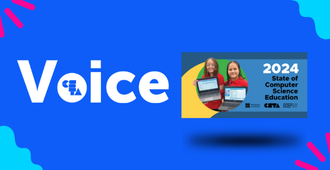After completing my week of professional development in computer science at The Citadel, in Charleston, South Carolina, this summer, it became apparent the role and responsibilities of teachers changed in my mind at the conclusion of the training. My cohort’s training session consisted of middle and high school teachers who were certified to teach math, science, social studies, and English. A few other teachers, including myself, teach computer science classes. Our training instructors impressed upon us the importance of embracing artificial intelligence and not being afraid (emphasis added) to incorporate it into our respective classes. Collectively, many of my colleagues uttered, “How? We don’t know anything about computer science, let alone artificial intelligence.” Although I am certified to teach computer science, I was intrigued to discover how teachers in traditional content areas could do the same. Thus, our journey into machine learning began.
In 2023, the Pew Research Center concluded, Artificial Intelligence is fast becoming a regular part of everyday life. It shapes the way we work, play, and receive essential services from food delivery to financial services to health care. 1 In short, AI has arrived and is only becoming more prevalent. The reality is AI chatbots have permanently changed the way we conduct our personal and professional affairs. For example, those who do their online banking with Bank of America may be entrusting their banking questions to “Erica”, their virtual banking assistant. “Erica” is trained to provide its bank customers the status of their financial transaction, assist customers with disputing a transaction, answer questions related to fees charged, and conduct money transfers. Since launching in 2018, Erica is believed to have “topped 1 billion client interactions, at 1.5 million a day.”2 I wonder how many customers unknowingly interact with a “person” who is not a person at all?
How often has an Amazon customer interacted with Amazon’s Seller Messaging Assistant bot? Customers can conveniently make inquiries about the status of an order, delivery, or return. The assistant presents with, “Hi, I’m the messaging assistant for Amazon’s selling partners. Is this what you need help with?”3 A photo of the item in question is depicted to help facilitate the conversation. If the subject matter of the initial conversation does not pertain to the depicted item, the Bot has learned to ask, “Did you have questions about something else?”
AI chatbots have become increasingly prevalent for over the last decade. It is estimated that there are billions of bots in operation today,4 and nearly 50% of all Internet traffic came from bots in 2022.5 OpenAI’s release of ChatGTP on Nov. 30, 2022, created hysteria among educators while heightening the curiosity of the population they serve. It quickly became a part of our culture before we knew what was happening. Its current version, ChatGPT4, is readily available and in the hands of its users, accessible via an app from our cell phones or iPads. With a carefully crafted prompt, users are able to receive learning assistance, generate creative ideas, and automate menial tasks (i.e. draft emails and record-keeping).6
When I became aware of ChatGPT in the fall of 2022, my reaction was similar to that of my teaching colleagues: What is it? How will we get students to do their own work? How are we supposed to stop them from using it? What is the school district doing about it? In The Creative ways teachers are using ChatGPT in the classroom, Olivia Waxman wrote, “The majority of the teachers are panicked because they see [ChatGPT] as a cheating tool, a tool for kids to plagiarize.”7 However, there are teachers, who are willing to adopt Bots like ChatGPT, as helpers capable of “explaining similar topics . . . , in order to free up time to discuss [deeper] analytical concepts . . . .” Admittedly, I am still trying to discern how I might incorporate AI Bots into my classes, and how to teach my students to employ them. Through the use of machine learning platforms like Quick Draw with Google, my students understand that Bots have limitations. Bots are limited by the information they are provided through the depth of our interactions with it. Only with the information humans provide are computers and machines able to function intelligently (i.e. make predictions on drawings, or solve problems).
It is becoming clear that my students need to develop an appreciation for what we tout as machine learning. Submitting to fear of the unknown, and attempting to prevent access to it is not an option. School districts need to re-evaluate and consider amending their Responsible Use Policies and grant teachers the authority to vet AI platforms, and permit them, along with their administrative team, to decide which AI platforms are conducive to a particular curriculum and will be subsequently introduced to students.
Bots like “Kuki” are effective platforms that can help students learn how to distinguish between human and bot interaction. It is a helpful tool to develop their prompt engineering skills (how to structure or modify a query to obtain the desired information that can be correctly interpreted and understood by a generative AI bot). In English classes, bots can be effective methods for students to practice their interpersonal skills, engage in brainstorming, and foster collaboration.8
Teachers and their districts can no longer afford to remain in the position of playing catch up. We are now equipped with an opportunity to leverage AI to support student learning, and differentiate instruction in our classrooms. “If designed properly, AI can help make decisions that are fairer because computers are purely logical. In theory, they are not subject to unconscious biased decision making.”9 Since the shutdown of our schools due to COVID, heightening engagement between students and teachers in schools is paramount. AI presents an opportunity to help students to explore their world, and critically examine content knowledge. It is not likely to change the basics of schooling.10 However, the key is to make sure educators are helping all students understand the importance of utilizing AI bots, like ChatGPT, responsibly and ethically in our schools. This is undoubtedly our greatest challenge.
About the Author

Dr. Elvage Girard Murphy
After retiring from the practice of law, and a full professorship at a university, Elvage Murphy accepted the challenge of teaching middle school students with the hope of helping children prepare to make a successful transition into adulthood. He accepted the responsibility of teaching website design and computer programming, with limited familiarity in the field. His commitment to make this successful career transition speaks to and inspires his students to believe they can learn and excel in computer science.
Footnote
- Pew Research Center, Kennedy, B. , Tyson, A, and Saks, E. (2023). Public awareness of artificial intelligence in everyday activities. Retrieved from https://www.pewresearch.org/science/2023/02/15/public-awareness-of-artificial-intelligence-in-everyday-activities/ ↩︎
- Bank of America. (2022, October 25). Bank of America’s Erica tops 1 billion client interactions, now assisting with 95% of digital banking requests. Bank of America Newsroom. Retrieved from https://newsroom.bankofamerica.com/content/newsroom/press-releases/2022/10/bank-of-america-s-erica-tops-1-billion-client-interactions–now-.html ↩︎
- Amazon.com. (2023). ↩︎
- Team Capacity. (2022, June 27). How many bots are on the Internet? Capacity.com. Retrieved from https://capacity.com/how-many-bots-are-on-the-internet/ ↩︎
- Security Staff. (2023, May 11). 47% of All Internet traffic came from bots in 2022. Security Magazine. Retrieved from https://www.securitymagazine.com/articles/99339-47-of-all-internet-traffic-came-from-bots-in-2022 ↩︎
- Marr. B. (2023, May 19). A Short History of ChatGPT: How we got to where we are today. Forbes. Retrieved from https://www.forbes.com/sites/bernardmarr/2023/05/19/a-short-history-of-chatgpt-how-we-got-to-where-we-are-today/ ↩︎
- Waxman, O. 2023, August 8. The Creative ways teachers are using ChatGPT in the classroom. Time. Retrieved from https://time.com/6300950/ai-schools-chatgpt-teachers/ ↩︎
- The AI Classroom Facebook page. (2023). Retrieved from https://www.facebook.com/groups/aiclassroom/ ↩︎
- Dusek, B. and Swick, T., Dr. (2023). Integrating AI. [Google slides]. Computer Science Profession Development, Charleston, South Carolina. ↩︎
- Waxman, (2023). ↩︎




